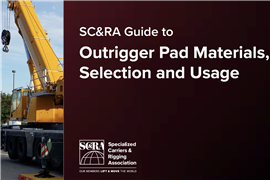Coming of age
25 April 2008
Companies throughout the world should brace themselves for a demographic sea change being created by the aging workforce. The United States workforce alone includes more than 69 million workers aged 40 or older, representing 48% of the nation's total workers.
As the baby boomers (age 41-60) retire, certain industries and occupations will find the replacement pool of new and younger workers inadequate. A study funded by the American Trucking Associations forecasts that 219,000 new drivers will need to be found to replace drivers 55 and older who will retire in the next decade. There's little reason to believe that the crane and rigging side will not face a similar challenge.
The stark realities of the aging workforce, however, eventually may transform the way that employers and employees think about work and retirement. With increases in longevity, many workers recognize that they may need to stay in the workforce longer to fund their retirement, which could last 30 years or more.
Employers that make a long-term commitment to accommodate their older workers stand to reap the benefits. For the most part, though, employers have been slow to adjust.
More than one-third of all employers - and nearly half with 25,000 or more workers - agree that the aging workforce will have a significant impact on their company. Yet more than three-quarters have not taken any steps to accommodate older workers, according to the 2005/2006 MetLife Employee Benefits Trend Study.
There is much to like about older workers. The Met Life study found that they are generally more satisfied with their jobs and more loyal to employers than their counterparts; 67% of pre-retirees (age 61-69) reported high levels of job satisfaction and 75% indicated that they were very loyal to their employers, compared to 44% and 46%, respectively, of all employees. They are also more likely to report that benefits are an important reason they remain with their employer than their colleagues.
On the flip side, companies must grapple with a host of benefits-related issues specific to aging employees. In particular, senior management ranked “health-care costs” as their top benefits- related concern.
Improvements in the equipment used in our industry may serve to counter this concern. Compare today's air-conditioned, cushy, smooth-riding trucks with the rattletraps of yesteryear. Similar progress has been made in the comfort of crane cabs.
Quite simply, the old equipment could wear down an operator. It contributed to various ailments and led to premature aging. Not only will comfortable heavy equipment keep operators from fleeing to other careers, it very well may enable them to stay productive for many more years.
Workplace computing, too, can ensure that an aging workforce remains healthy and helpful. The use of computers has expanded to include a variety of devices, applications and occupations.
Use goes beyond the desktop to the construction site, the truck terminal or the production shop floor. While a 55-year-old man may no longer have the strength and stamina to work on a traditional assembly line alongside a 25-year-old colleague, he may be equally adept at operating robotic equipment that can accomplish even more.
Beyond creating a less demanding physical environment, employers often can appeal to older workers by offering flexible work schedules. Those part-time positions that seem so difficult to fill might be ideal for older professionals looking to supplement retirement income. (The MetLife study found that outliving retirement money is the number one retirement-related fear of baby boomers.)
Who knows? If older workers have already had long, distinguished careers in our industry, they may be able to share valuable lessons about techniques and strategies that otherwise might be lost forever.
As the pool of available workers begins to dry up, it will become crucial for our member companies to identify a strategy for retaining trained, experienced workers and keeping them satisfied and engaged. Just as we do with other important issues affecting our membership, SC&RA will keep an eye on developments involving the aging workforce and provide the information members need to make prudent decisions. •


